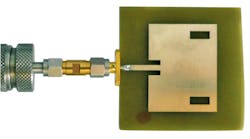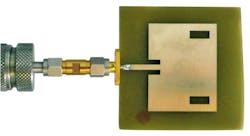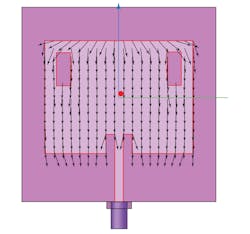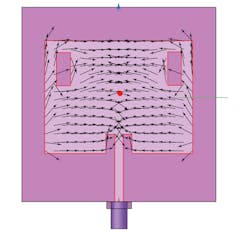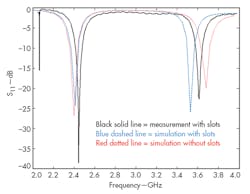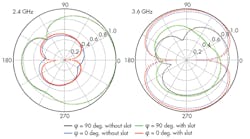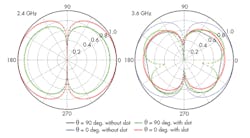This file type includes high resolution graphics and schematics when applicable.
As wireless applications continue to expand, antennas that can handle more than one frequency band are gaining in importance. For two of the more popular wireless frequency bands—those for Wi-Fi/WiMAX applications at 2.4 and 3.6 GHz—a microstrip patch antenna was developed in a compact size and with versatile frequency characteristics. The microstrip circuit is capable of multiple resonant frequencies.
When the antenna is designed for 2.4 GHz, its higher resonance frequency will be around 3.7 GHz or beyond the target 3.6-GHz frequency. By adding two rectangular slots on the patch area, the higher resonance frequency shifts down in frequency (from 3.7 to 3.6 GHz). Because the slots are cut inside the patch area, the radiation pattern of the antenna remains unaffected, and dual resonance antenna can be realized without an increase in size. The antenna achieves desirable directional radiation patterns at both 2.4 and 3.6 GHz.
Many dual-band antennas have been designed and fabricated for wireless applications in recent years.1-10 Most have been designed for omnidirectional purposes such as in cell phones and for wireless links in computers. But for indoor wireless access points (AP) or point-to-point (P2P) communications, more directivity is usually required.11-13 As an example, Wi-Fi/WiMAX antennas, operating at 2.4/3.6 GHz frequency bands, are usually designed with directional patterns for the highest gain,14,15 as well as for compact size and low profile. Although many dual-band antennas have been developed recently,16,17 many are stacked18-21 or suffer high-profile22-24 configurations.
As a possible solution, a dual-band directional slotted microstrip antenna was developed for Wi-Fi/WiMAX applications. It consists of a rectangular patch acting as the radiator, in addition to two rectangular slots that are added to the structure symmetrically in order to modify the resonance frequency. This dual-band antenna achieves high directivity in both lower and upper bands. The return loss and radiation patterns of the antenna have been analyzed by computer simulations, with results validated by experimental measurements.
Figure 1 shows the dual-band rectangular microstrip antenna, realized by means of two symmetrical rectangular slots on the patch area; the slots are added symmetrically The dimensions of the patch area are L = 29 mm and W = 38 mm. The inset microstrip feed dimensions are 2.2 mm width and 17.3 mm length. The slot length is 8.5 mm with width of 3.5 mm. The antenna is fabricated on double-sided FR4 circuit-board material, 1.6 mm in height, with relative dielectric constant, εr, of 4.4. The back side of the antenna is the ground plane. A microstrip line feeds the antenna, and impedance matching is achieved by means of inset feed. The signal is connected to the microstrip line by an SMA connector soldered at the edge.
Having the relative permittivity (εr) and height of the substrate (h), we want to design the antenna to correspond to the first resonance frequency of fr = 2.4 GHz. The width of the antenna can be achieved via equation 1. Practically speaking, fields will not be confined to L or W. Due to the fringing filed effect, a fraction of the field lies outside the physical dimensions. Therefore, the effective antenna length is 2ΔL larger than its physical length, as demonstrated by Eqs. 1-425,26:
W = 1/2fr(μ0ε0)0.5 × [2/(εr + 1)]0.5 (1)
εeff = (εr + 1)/2 + (εr – 1)/2[1 + (12h/W)]0.5 (2)
ΔL = (0.412/h)[εeff + 0.3)(W/h + 0.264)/εeff – 0.258)(W/h + 0.8)] (3)
L = 1/[2fr(εeff)0.5 × (μ0ε0)0.5] - 2ΔL (4)
For a matching procedure by inset feed line, the gap has the same width as the microstrip line, and the feed position from the center (x) is calculated by Eq. 527:
Rin = Redgesin4(πx/L)0 ≤ x ≤ L/2 (5)
where:
Rin = the input impedance to match with the antenna, and
Redge = the input impedance of the rectangular patch at its feeding edge.
The antenna’s fundamental TM10 mode supports the 2.4-GHz band. By adding slots with proper shapes and at appropriate positions inside the patch, a dual-band antenna can be realized without an increase in size—leaving its radiation patterns unperturbed, in turn.28 Adding two slots reduces the higher-order TM02 mode and realizes the desired higher frequency band for the antenna.
This file type includes high resolution graphics and schematics when applicable.
Modeling and Measuring
This file type includes high resolution graphics and schematics when applicable.
To better understand the performance of the dual-band antenna, the surface-current distributions of the design were studied in Fig. 2 for 2.4 GHz and in Fig. 3 for 3.6 GHz. The TM10 mode is dominant at 2.4 GHz, with surface currents showing a half-wavelength change along the patch’s length. Adding slots had less effect on the surface current distribution at lower-frequency bands. Since the TM02 mode is dominant at 3.6 GHz, when a pair of slots is cut from places where the current for the TM02 mode is maximum, a maximum reduction in the higher-frequency band will occur.
The slots modify the antenna’s current distribution and increase the electrical length of the antenna. Although the changes in the position of the feed inset alter the input impedances at the dual frequencies, both frequencies will remain almost constant. The perturbation in surface current distributions increases with the length of the slots.28
The two rectangular slots reduced the higher-order orthogonal TM02 mode resonance frequency from 3.7 GHz to 3.6 GHz, owing to the excitation of the higher-order TM02 mode. Because both slots are parallel to the current for the TM10 mode, and the slot length is larger than its width, the lower-frequency performance remains almost constant when the slot length is increased. At higher frequencies, based on the positions of the slots, the slot can increase the length of the surface currents.
To evaluate the dual-band antenna design, it was fabricated on FR4 and measurements of return loss performed (Fig. 4). The return loss was compared with and without slots, and these test results were found to agree closely with computer simulations for the slotted antenna. The cut slots affect the higher resonance frequency band but have little impact on the lower resonant frequency band.
Measurements of S11 for the antenna’s lower-frequency bandwidth were better than -10 dB from 2.412 to 2.478 GHz. This frequency band covers channels 1 to 13 for Wi-Fi applications and the antenna can be used for Wi-Fi applications for channels 1, 6, and 11 for the IEEE 802.11b protocol; for channels 1, 5, 9, and 13 for IEEE 802.11g/n; and for channels 3 and 11 for the IEEE 802.11n protocol. The return loss for the higher-frequency band was better than -10 dB from 3.58 to 3.65 GHz, suitable for WiMAX applications.
Free-space E- and H-plane pattern measurements were also made on the prototype antenna, with gain of θ and gain of φ presented in Figs. 5 and 6, respectively. The radiation pattern gain (θ is a maximum for 2.4 GHz at 0 deg. when φ = 90 deg. The gain θ is leaning towards 0 deg. due to the ground plane. The pattern is almost symmetrical for φ = 0 deg. although it is particularly weak, with almost no current contributing to it. The added slots to not change the surface current distributions at lower-frequency bands, so the radiation patterns are almost similar at 2.4 GHz with or without slots.
The effects of the slots are more pronounced at higher frequencies. The radiation pattern for 3.6 GHz is a maximum at 90 and 270 deg., with two nulls at 0 and 180 deg. Although the gain θ when φ = 90 deg. is lower than when φ = 0 deg., the difference is not as great as at the lower-frequency band. The radiation pattern is closer to being omnidirectional at the higher resonant frequency. When the length of the slots increases, the surface currents are directed along the length of the slots. By increasing the lengths of the slots, the radiation pattern becomes more broadsided.
The gain φ exhibits almost similar patterns for θ = 0 deg. and θ = 90 deg. at 2.4 GHz. The antenna patterns are omnidirectional, with two nulls at 90 and 270 deg. At 3.6 GHz, adding slots reduced the magnitude of the gain φ compared to that at 2.4 GHz. The pattern shape after adding slots for θ = 0 deg. remained similar, and only the magnitude level dropped. For θ = 90 deg., the magnitude level remained unchanged, but two dents were detected at φ = 188 deg. and φ = 350 deg.
In short, it was possible to produce a dual-band antenna for Wi-Fi/WiMAX using a rectangular microstrip patch, with two rectangular slots on the patch area and inset feeding. The two frequency bands step from the TM10 and TM02 microstrip modes. The antenna provides lower-frequency coverage of 2.412 to 2.478 GHz and higher-band coverage of 3.58 to 3.65 GHz, with proper radiation patterns in both bands. The antenna’s simple planar structure makes for ease of fabrication for Wi-Fi/WiMAX applications.
Mohammad Mahdi Shafiei, Research Assistant
Department of Electrical Engineering, Faculty of Engineering, University of Malaya, Malaysia
Mahmoud Moghavvemi, Professor
Centre of Research in Applied Electronics (CRAE), Department of Electrical Engineering, Faculty of Engineering, University of Malaya, Malaysia
Dr. Wan Nor Liza Mahadi, Doctor
ElectroMagnetic Radiation and Devices Research Group (EMRD), Department of Electrical Engineering, Faculty of Engineering, University of Malaya, Malaysia
This file type includes high resolution graphics and schematics when applicable.
References
This file type includes high resolution graphics and schematics when applicable.
1. K. Ding, T. Yu, Q. Zhang, and K. Luo, “Dual-band Circularly Polarized Aperture Coupled Annular-ring Microstrip Antenna for GNSS Applications,” in Frequenz, Vol. 68, 2014, p. 19.
2. V. Sharma and M.M. Sharma, “Wideband Gap Coupled Assembly of Rectangular Microstrip Patches for Wi-Max Applications,” in Frequenz, Vol. 68, 2014, p. 25.
3. A. Narbudowicz, B. Xiu Long, and M.J. Ammann, “Dual-Band Omnidirectional Circularly Polarized Antenna,” IEEE Transactions on Antennas and Propagation, Vol. 61, 2013, pp. 77-83.
4. C. Shih-Hsun and L. Wen-Jiao, “A Novel Dual Band Circularly Polarized GNSS Antenna for Handheld Devices,” IEEE Transactions on Antennas and Propagation, Vol. 61, 2013, pp. 555-562.
5. X.L. Sun, S.W. Cheung, and T.I. Yuk, “Dual-Band Monopole Antenna With Frequency-Tunable Feature for WiMAX Applications,” IEEE Antennas and Wireless Propagation Letters, Vol. 12, 2013, pp. 100-103.
6. P. Borah, A.K. Bordoloi, N.S. Bhattacharyya, and S. Bhattacharyya, “Bridged ‘V’-shaped patch antenna for dual-band communication,” Electronics Letters, Vol. 48, 2012, pp. 419-420.
7. F. Mirzamohammadi, J. Nourinia, and C. Ghobadi, “A Novel Dual-Wideband Monopole-Like Microstrip Antenna With Controllable Frequency Response,” IEEE Antennas and Wireless Propagation Letters, Vol. 11, 2012, pp. 289-292.
8. M. Gaffar, M.A. Zaman, S.M. Choudhury, and M.A. Matin, “Design and optimisation of a novel dual-band circularly polarised microstrip antenna,” IET Microwaves, Antennas & Propagation, Vol. 5, 2011, pp. 1670-1674.
9. O. Quevedo-Teruel, M.N.M. Kehn, and E. Rajo-Iglesias, “Dual-Band Patch Antennas Based on Short-Circuited Split Ring Resonators,” IEEE Transactions on Antennas and Propagation, Vol. 59, 2011, pp. 2758-2765.
10. M.A. Al-Joumayly, S.M. Aguilar, N. Behdad, and S.C. Hagness, “Dual-Band Miniaturized Patch Antennas for Microwave Breast Imaging,” IEEE Antennas and Wireless Propagation Letters, Vol. 9, 2010, pp. 268-271.
11. Q. XuLin, L. RongLin, C. YueHui, and M.M. Tentzeris, “Analysis and Design of a Compact Dual-Band Directional Antenna,” IEEE Antennas and Wireless Propagation Letters, Vol. 11, 2012, pp. 547-550.
12. C.R. Medeiros, E.B. Lima, J.R. Costa, and C.A. Fernandes, “Wideband Slot Antenna for WLAN Access Points,” IEEE Antennas and Wireless Propagation Letters, Vol. 9, 2010, pp. 79-82.
13. R. Gardelli, G. La Cono, and M. Albani, “A low-cost suspended patch antenna for WLAN access points and point-to-point links,” IEEE Antennas and Wireless Propagation Letters, Vol. 3, 2004, pp. 90-93.
14. Z. Hongjiang, Y. Abdallah, R. Chantalat, M. Thevenot, T. Monediere, and B. Jecko, “Low-Profile and High-Gain Yagi Wire-Patch Antenna for WiMAX Applications,” IEEE Antennas and Wireless Propagation Letters, Vol. 11, 2012, pp. 659-662.
15. T. Wu, L. Rong-Lin, E. Soon Young, M. Seong-Sik, L. Kyutae, J. Laskar, et al., “Switchable Quad-Band Antennas for Cognitive Radio Base Station Applications,” IEEE Transactions on Antennas and Propagation, Vol. 58, 2010, pp. 1468-1476.
16. G. Ghobadi and M. Majidzadeh, “Compact Antenna Snares WiMAX/WLAN,” Microwaves & RF, May 2014.
17. X.-D.Y. Yin-Song Li, Yu Bai, and Tao Jiang, “Dual-Band Antenna Handles WLAN/WiMAX,” Microwaves & RF, June 2011.
18. K. Jain Satish and S. Jain, “Performance Analysis of Coaxial Fed Stacked Patch Antennas,” in Frequenz Vol. 68, 2014, p. 7.
19. M. Chen and C.C. Chen, “A Compact Dual-Band GPS Antenna Design,” IEEE Antennas and Wireless Propagation Letters, Vol. 12, 2013, pp. 245-248.
20. T. Fujimoto and S. Fukahori, “Broadband dual-band stacked square microstrip antenna with shorting plates and slits,” IET Microwaves, Antennas & Propagation, Vol. 6, 2012, pp. 1443-1450.
21. M.I. Sabran, S.K.A. Rahim, A.Y.A. Rahman, T.A. Rahman, M.Z.M. Nor, and Evizal, “A Dual-Band Diamond-Shaped Antenna for RFID Application,” IEEE Antennas and Wireless Propagation Letters, Vol. 10, 2011, pp. 979-982.
22. H.T. Hsu and T.J. Huang, “Generic dipole-based antenna-featuring dual-band and wideband modes of operation,” IET Microwaves, Antennas & Propagation, Vol. 6, 2012, pp. 1623-1628.
23. H. Tiwari and V. Kartikeyan Machavazam, “A Stacked Microstrip Patch Antenna Loaded With U-Shaped Slots,” in Frequenz, Vol. 65, 2011, p. 167.
24. P. Lindberg, E. Ojefors, Z. Barna, A. Thornell-Pers, and A. Rydberg, “Dual wideband printed dipole antenna with integrated balun,” IET Microwaves, Antennas & Propagation, Vol. 1, 2007, pp. 707-711.
25. R. Garg, Microstrip antennas design handbook, Artech House, Boston, MA, 2001.
26. M.M. Shafiei and M. Roslee, “A Compact Slotted Bowtie Patch Antenna,” in The 2009 International Symposium on Antennas and Propagation (ISAP 2009), Bangkok, Thailand, 2009, pp. 349-352.
27. T.A. Milligan, Modern Antenna Design, 2nd ed., IEEE Press/Wiley Interscience, Hoboken, NJ, 2005.
28. A.A. Deshmukh and K.P. Ray, “Formulation of Resonance Frequencies for Dual-Band Slotted Rectangular Microstrip Antennas,” IEEE Antennas and Propagation Magazine, Vol. 54, 2012, pp. 78-97.
This file type includes high resolution graphics and schematics when applicable.
